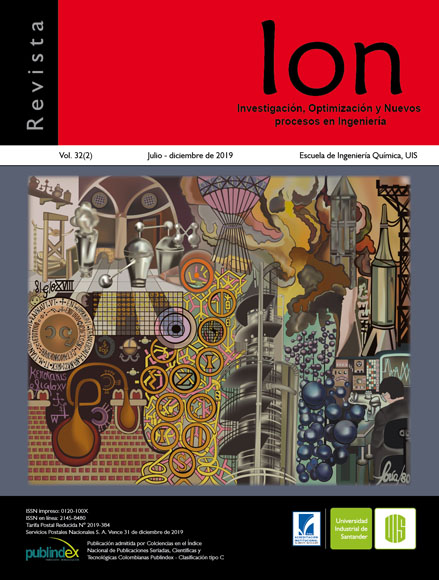Published 2019-11-12
Keywords
- Enzyme,
- Adsorption,
- Porous Material
How to Cite
Abstract
The immobilized enzymes are catalysts of great industrial interest, as it unites the advantages of heterogeneous catalysis with the high selectivity and mild operation conditions of the enzymes. Biochar is a porous carbonaceous material, which have characteristic that it makes a strong candidate to incorporate enzymes in its structure. Another relevant fact is the possibility of changes and adaptations by synthesis condition in the Biochar structure due to the application needs. In this context, the objective of this work was the study of immobilization of lipase in a biochar produced by pyrolysis (600 oC) from an agricultural residue called cassava stump. It was evaluated different enzymatic concentrations (0.1, 0.25 and 0.5 g/L) in order to determine the affinity between the enzyme and biochar. The obtained results showed that the enzyme studied could be easily immobilized in the biochar, obtaining as immobilization yield 61.2 % when using the highest concentration of enzymes.
Downloads
References
[2] Bobbio FO, Bobbio PA. Introdução à Química de Alimentos. 2. ed. São Paulo: Varela;1995.
[3] Faber K. Biotransformations in Organic Chemistry. 6. ed. Berlin: Springer-Verlag; 2011.
[4] Ribeiro LMO, Falleiros LNSS, de Resende MM. et al. Immobilization of the enzyme invertase in SBA-15 with surfaces functionalized by different organic compounds. J Porous Mater. 2019;26:77-89.
[5] Moffat G, Williams R, Webb C, Stirling R. Selective separations in environmental and industrial processes uding magnetic Carrier technology. Minerals Engineering. 1994;7(8):1039-56.
[6] Palomo JM, Segura RL, Fernandez-Lorente G, Fernandez-Lafuente R, Guisán JM. Glutaraldehyde modification of lipases adsorbed on aminated supports: A simple way to improve their behaviour as enantioselective biocatalyst. Enzyme and Microbial Technology. 2007;40(4):704-7.
[7] Cantarelli C. The use of immobilized yeasts in wine fermentation. Journal of Food Science. 1989;3:3-20.
[8] Canilha L, Carvalho W, Silva JBA. Biocatalisadores imobilizados. Biotecnologia Ciência e Desenvolvimento. 2006;ano IX(36):48-57.
[9] Marquez LDS, Cabral BV, Cardoso VL, Ribeiro, EJ. Optimization of invertase immobilization by adsorption in ionic exchange resin for sucrose hydrolysis. Journal of molecular catalysis B: Enzymatic. 2008;51(3-4):86-92.
[10] Yang LM, Wang YJ, Luo GS, Daí YY. Functionalization of SBA-15 mesoporous sílica with thiol or sulfonic acid groups under the crystallization conditions. Microporous and Mesoporous Materials. 2005;84(1-3):275-82.
[11] Vieira EA. Recursos genéticos e melhoramento da mandioca. Brasil: Empresa Brasileira de Pesquisa Agropecuária - Embrapa Cerrados Ministério da Agricultura, Pecuária e Abastecimento; 2011.
[12] Khadem A, Raiesi F. Influence of biochar on potential enzyme activities in two calcareous soils of contrasting texture. Geoderma. 2017;308:149–58.
[13] Demisie W, Liu Z, Zhang M. Effect of biochar on carbon fractions and enzyme activity of red soil. Catena. 2014;121:214–21.
[14] Günal E, Erdem H, Demirbaş A. Effects of three biochar types on activity of β-glucosidase enzyme in two agricultural soils of different textures. Archives of Agronomy and Soil Science. 2018;64(14):1963-74.
[15] Wang X, Song D, Liang G, Zhang Q, Ai C, Zhou W. Maize biochar addition rate influences soil enzyme activity and microbial community composition in a fluvo-aquic soil. Appl Soil Ecol. 2015;96:265–72.
[16] Dixon M, Webb EC. Enzymes. 3. ed. London: Longman Group; 1979.
[17] Arroyo M. Inmobilización de enzimas. Fundamentos, métodos y aplicaciones. Ars Pharmaceutica. 1998;39(2):23-39.
[18] Uhlig H. Industrial enzymes end their applications. New York, United States: John Wiley & Sons; 1998.
[19] Michaelis L, Menten ML. Kinetics of invertase action. Biochemische Zeitschrift. 1913;49:333-69.
[20] Meili L, Godoy RPS, Soletti JI, Carvalho SHV, Ribeiro LMO, Silva MGC, Gimenes ML. Cassava (Manihot esculenta Crantz) stump biochar: Physical/chemical characteristics and dye affinity. Chemical Engineering Communications. 2019;206(7):829-41.
[21] Bradford MM. A rapid and sensitive method for the quantitation of microgram quantities of protein utilizing the principle of protein-dye binding. Analytical Biochemistry. 1976;72(1-2):248-54.
[22] Hermanová S, Zarevúcká M, Bousa D, Pumera M, Sofer Z. Graphene oxide immobilized enzymes show high thermal and solvent stability. Nanoscale. 2015;7(13):5852-8.
[23] Motta VT. Enzimas. In: Bioquímica básica. Motta VT. Brasil: MedBook; 2011. p. 68-101.
[24] Moré JJ. The Levenberg–Marquardt Algorithm: Implementation and Theory. In: Numerical analysis. Moré JJ. Berlin: Springer; 1977. p. 105–16.
[25] González ME, Cea M, Sangaletti N, González A, Toro C, Diez MC, Navia R. Biochar Derived from Agricultural and Forestry Residual Biomass: Characterization and Potential Application for Enzymes Immobilization. Journal of Biobased Materials and Bioenergy. 2013;7(6):724–732.doi.org/10.1166/jbmb.2013.1373.
[26] Almeida Lays C, Barbosa Anderson S, FricksAlini T, Freitas Lisiane S, Lima Alvaro S, SoaresCleide MF. Use of conventional or non- ́ conventional treatments of biochar for lipase immobilization. Process Biochemistry. 2017;61:124-9.http://dx.doi.org/10.1016/j.procbio.2017.06.020.
[27] Li N, Xia Q, Niu M, Ping Q, Xiao H. Immobilizing Laccase on Different Species Wood Biochar to Remove the Chlorinated Biphenyl in Wastewater. Scientific reports. 2018;8(1):1-9.
[28] Santos MP, Brito MJ, Junior EC, Bonomo RC, Veloso CM. Pepsin immobilization on biochar by adsorption and covalent binding, and its application for hydrolysis of bovine casein. J. Chem. Technol. Biotechnol. 2019;94(6):1982-90. https://doi.org/10.1002/jctb.5981.

